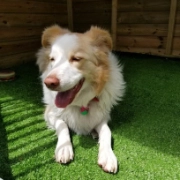Separation Anxiety in Dogs
Separation anxiety is a seriously distressing issue, and dogs that suffer from it can become incredibly destructive in their bid to escape the house. I have seen dogs chew through solid wooden doors, scratch walls away to practically nothing, and even break door handles off. Obviously, none of these would appeal to a potential landlord!
In lighter cases, we have several ways at PetVilla to address these issues. But in more severe cases, it requires training – and best it to be done by the Owner.
Working on your dog’s separation anxiety is by far the kindest thing you can do for them. This is a highly distressing condition and your dog will be a lot more relaxed if they’re able to overcome this. It’s also a lot easier on you, knowing you don’t have to worry about your dog when you need to go out!
Here are some practical tips to help you work through this.
- Consider where you are leaving your dog
Most dogs will be more settled if they have access to a social area of the home as well as outdoor space, so consider a dog door so your dog can get inside (or create a restricted space inside they can access e.g. a play pen or crate off a dog door in the lounge or kitchen). A restricted area is a good idea if your dog is prone to destructive behaviour! You can buy inserts for sliding doors from Bunnings Warehouse that give you a rental-friendly dog door. It can be as simple as a crate inside the dog door that allows them in to sleep and rest inside, and get outside to play. - Create a safe set up
Give them a covered crate to settle in as a safe space, and leave something smelling of you in there (like a worn t-shirt). Making it small and dark will help your dog feel safer and more comfortable. It’s ok to close them in a crate for an hour or two but not much longer than that. - Keep departures low key
Avoid making a big fuss when leaving or returning home, as it can create anxiety for your dog. Keep your departures and arrivals low-key and calm to minimise stress. The differential between when you’re there or not should be minimised. - Distraction
Give your dog a stuffed Kong, food puzzle or bone when you’re leaving to help them initially settle. Ensure your dog has plenty of chew toys to distract them when you’re gone. Try leaving the TV or radio on to provide comforting background noise. - Practice alone time
Practise leaving your dog alone for short periods of time, even when you’re at home (a crate or a clip station is a great way to do this). This can help them learn that being alone is okay, start with short periods of time (5 minutes or less) and give your dog a stuffed Kong or chew bone to distract them, then gradually work up to longer stretches, by 15 minutes, 30 and half a day (see next step “Treat the Issue“). Even just having your dog clipped up or in a crate as you come and go from the room doing chores is a good way to practise separation.
Keep in mind: Separation Anxiety very often comes from abandonment issues. Your Dog will learn that your leaving is not the same as abandoning him or her and that you return. Especially at the beginning of the process, and helps to return with a treat – acting like the Alpha Dog of a Pack that brings back food to his pack. - Treat the Issue
Treating separation anxiety will require a technique called Graduated Departure. This is where you slowly and systematically teaching your dog to adjust to not having you there. We cover it in this blog: https://dogzen.com/help-dog-separation-anxiety/ . Such practice is very important before brining a Dog to a Boarding Kennel or even when he is looked after a Pet Sitter. - Company
Many dogs will be happier in the company of another dog. Do you have a nearby friend or neighbour with a dog your dog gets along great with? If so, consider if you can leave them together some days – at the other person’s place if it hasn’t been agreed with your landlord. Alternatively, doggy daycare or a dog walker can break up a long day away from your dog. - Relaxation Aids
Rescue Remedy and Thunder Jackets help some dogs relax. In the case of severe anxiety, your vet may be able to prescribe an anti-anxiety medication. - Treat-Dispensing Pet Cameras
A two-way camera that can dispense treats to your pet when you’re not there is an awesome tool to help with treating separation distress. You can help keep your dog calm from a distance! We have a blog here on how to incorporate this tool into your separation training: https://dogzen.com/pet-cameras-for-separation-anxiety/
If your dog has severe separation distress and does not cope when you need to leave the house, they may need more comprehensive treatment. In this case, join our Dog Zen Virtual Dog School as we cover this training in detail with videos to guide you through exactly what to do. I’ll also be on hand to help you through it.
There’s more info here if you’d like to check it out: https://dogzen.com/dogzen-virtual-dog-school/
Alternatively, some excellent Dog behaviour trainers are in the Kapiti Coast, like Pawsitive Behaviours.
This article is based on an Article published by Mark Vet, an Animal Behaviourist, and our knowledge and experience with dogs with separation anxiety. You can follow Mark on Facebook and his Website, with some Additions based on our Experience here at PetVilla.




